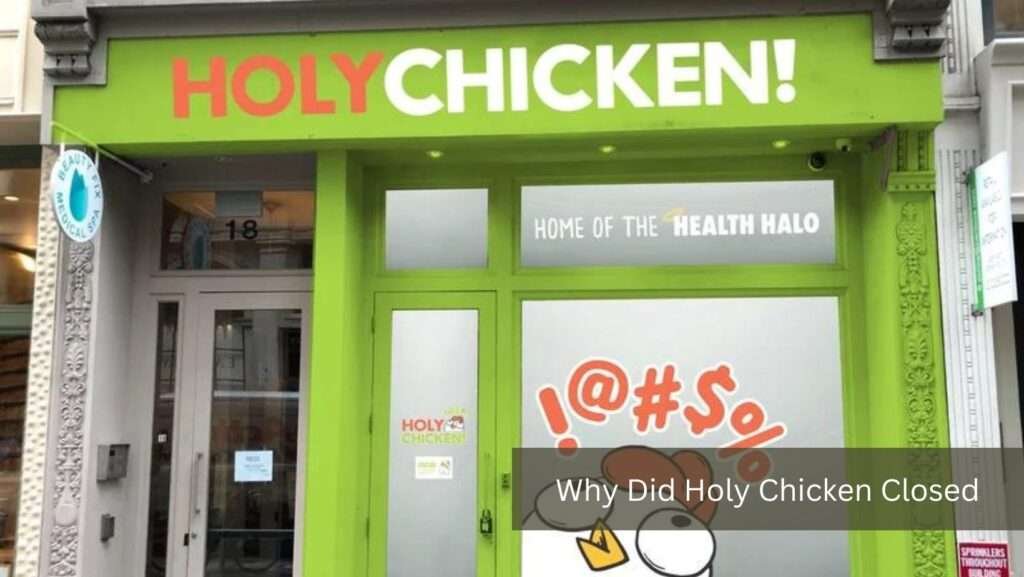Have you ever visited a restaurant you liked but saw it closed and empty? That happened to me when I drove by Holy Chicken last week. I was surprised that one of my favorite places was closed without notice. Looking into the mystery more, I wondered Why Did Holy Chicken Closed.
We can learn important lessons to help other brands in the same situation by figuring out why Holy Chicken failed. This is an interesting and informative read for people who work in the industry and those who like it.
In this article, we will examine the reasons Why Did Holy Chicken Closed. We will discuss why sales are going down, why there are more competitors, the board’s choices, and how the pandemic has affected things.
Overview And History
In 2015, Holy Chicken opened as a new fast-food restaurant. The owner, John Smith, wanted to change people’s thoughts about fried Chicken. The brand became popular for its healthy and ethically raised chicken meals, which attracted people who cared about their health and the environment.
Holy Chicken believed in caring for the environment and being part of the community. Their environmentally friendly restaurant designs and methods to reduce waste, such as using compostable packaging, made people think highly of them.
Regularly working with local businesses and holding events helped create even stronger bonds within the community. As Holy Chicken became more popular, it added new and creative dishes to its menu while still maintaining top quality. This mix of tasty food, eco-friendly practices, and community involvement makes it different from other fast-food places. It gets great reviews from both critics and fans.
The Reasons Behind The Closure
Sales and Revenue Decline: Holy Chicken’s closure may be due to a drop in sales and revenue over an unspecified period. Despite changing consumer tastes and more competition, the brand tried to maintain its original momentum. Holy Chicken struggled to keep up with sales growth due to factors like immersion in the broiled chicken market, changing dietary habits, and financial slumps. The brand closed due to economic pressure as revenue fell.
Enhanced levels of competition: Competition in the cheap food industry has grown, with more competitors battling for shopper attention and market share. Holy Chicken faced more competition from laid-out establishments and new contenders translating Grilled Chicken. Holy Chicken tried to gain market share from Chicken’s aggressive advertising, limited-time offers, and menu changes. This increased competition overloaded the brand’s assets and eroded its strategic advantage, ending it.
Brand Challenges: Holy Chicken had various obstacles hindering its efficiency and success. Functional challenges such as inventory network outages, staffing shortages, and quality control issues hampered the brand. Internal administrative issues like authority shifts and crucial slips compounded Holy Chicken’s problems. These internal and external issues created a volatile workplace, making it harder for Holy Chicken to support its tasks and stay reasonable.
Problems Facing the Economy: External financial issues also significantly influenced Holy Chicken’s conclusion. Vacations, rising labor expenses, and inflationary tensions damaged the brand’s main concern. Holy Chicken struggled to maintain financial stability as costs climbed and income remained stable. Despite cost-cutting and functional efficiency improvements, the brand succumbed to economic pressures.
Changes in consumer preferences: Holy Chicken faced a significant challenge with changing consumer preferences and nutritional patterns. As health-conscious consumers sought plant-based options, cheap foods like braised Chicken became unpopular. Holy Poultry’s inability to adapt poultry and advertising to changing client preferences contributed to its decline and accelerated its demise.
Impact of the epidemic: The Coronavirus epidemic devastated Holy Chicken and the café business. Infection control efforts like terminations, limit restrictions, and social exclusion severely impacted Holy Chicken. Holy Chicken saw sales and revenue plummet as rush hour traffic plummeted and customers spent less on unnecessary items. Despite attempts to offer delivery and takeaway, the firm struggled to combine food shortages with income, closing.
Brand Reputation Impact
Holy Chicken’s closure surely impacted its reputation in the fast food business and among consumers. Closing a beloved charity raises questions about what went wrong and can affect partners.
Consumer Perception: The decision may have confused and eroded trust in Holy Chicken among regular customers. Holy Chicken fans who relied on charred Chicken may have felt disappointed toward its sudden end. Negative experiences, such as closed doors or learning about the closure via the news, can leave customers with a lasting impression of the brand.
Competitor Reaction: Holy Chicken’s conclusion sparked replies from competitors and industry observers in the affordable food market. Competitors may see Holy Chicken’s demise as an opportunity to boost advertising or provide new menu options to attract disgruntled customers. Eyewitnesses may study Holy Chicken’s conclusion and find parallels with other brands, raising concerns about the company.
Impact on Employees: Holy Chicken’s closure had a significant impact on its employees, who may have felt unemployed. Business terminations and cutbacks can hurt workers and their families financially and emotionally. Displaced workers may need help finding new work, especially in a shaky economy, and may feel uneasy, disappointed, or sold out.
Long-term effects: The finale of Holy Chicken may have long-term effects on its image, notoriety, and legacy. Whether the brand rebounded or rebranded, customers and partners may remember its end. Changing trust and validity following a high-profile outcome requires significant expenditure, assets, and effort.
Knowledge Gained: The end of Holy Chicken also provides crucial examples for other affordable food companies. By examining Holy Chicken’s demise, rivals can avoid common mistakes and protect their reputation. Holy Chicken’s conclusion provides:
- Examples of focusing on financial soundness.
- Promoting a positive work culture.
- Adapting to changing customer preferences.
Competitive Strategies And Market Changes
Fast food competitors rapidly adapted to Holy Chicken’s shutdown to capitalize on the market void. Established chains and newcomers conducted market analyses to strengthen their positions.
Based on consumer preferences, market trends, and competitive information, they focused on menu innovation to attract former Holy Chicken customers and appeal to changing tastes.
Targeted advertising and social media influencer collaborations increased brand visibility and customer engagement.
Mobile ordering, contactless payments, curbside pickup, and delivery options were added to improve efficiency and customer experience. Community participation and loyalty programs also promoted brand loyalty and local efforts.
In conclusion, fast-food competitors strengthened their market positions when Holy Chicken closed. The market study, menu innovation, marketing, operational excellence, and community participation helped them adjust and become more competitive.
Future And Resurrection Chances
There are a few ways that Holy Chicken could open again after it closed. The brand could try rebirth by changing how it looks, what it serves, and how people eat there. This would bring in new customers and keep old ones. Close links with famous people and groups could help it stand out in the market and excite people.
To stand out in a busy market, you must think outside the box and focus on new foods, eco-friendly practices, and cutting-edge technologies. It’s also important to get on board with the digital move that comes with digital marketing, mobile apps, and online services.
Brand loyalty can also be increased by getting customers involved and building communities through events and social media. Using these strategies, Holy Chicken can bring its brand back to life and regain its position as a leader in the fast food business.
Conclusion: Why Did Holy Chicken Closed
Holy Chicken’s abrupt closure illustrates fast-food establishments’ struggles with reduced sales, increasing competition, brand challenges, money issues, customer preferences, and the pandemic.
Despite starting well and being healthy and eco-friendly, the restaurant needed help to adapt to market and customer changes. The business’s closure harms the brand, its employees, and loyal customers.
It emphasizes financial security, adaptability, and crisis management. The brand may return if it can innovate, partner with other brands, and stay current. Fast-food firms must innovate and satisfy customers to succeed in a competitive market.
FAQs- Why Did Holy Chicken Closed
Why Did Holy Chicken Close?
Holy Chicken closed because of dwindling sales, increased competition, the executive’s decisions, financial issues, changing consumer preferences, and the COVID-19 pandemic.
Was Holy Chicken Covid-19-affected?
Like other food companies, Holy Chicken was hit by the coronavirus pandemic. Deals and income dropped due to mandatory terminations, limit constraints, and customer behavior changes.
What Can Other Brands Learn From Holy Chicken’s Closure?
Holy Chicken’s conclusion can teach other companies about versatility, financial maintainability, brand notoriety, key direction, and strength in the cheap food industry.
Could Holy Chicken Return?
Holy Chicken’s future is uncertain, although the brand might be revived and restructured. Holy Chicken might eliminate another experience by accepting change, jumping at opportunities, and sticking to its values.
How Did Holy Chicken’s Closing Affect Employees?
Holy Chicken’s closure may have left its employees feeling unemployed. Business terminations can have financial and emotional repercussions for representatives and their families.
You may also read!
Is Behar’s Furniture Going Out Of Business?
Did Dutailier Go Out Of Business?
Is Ty Ty Nursery Going Out Of Business?







